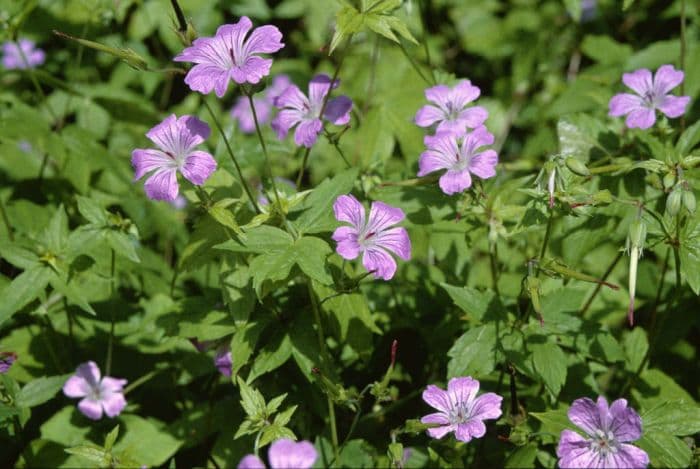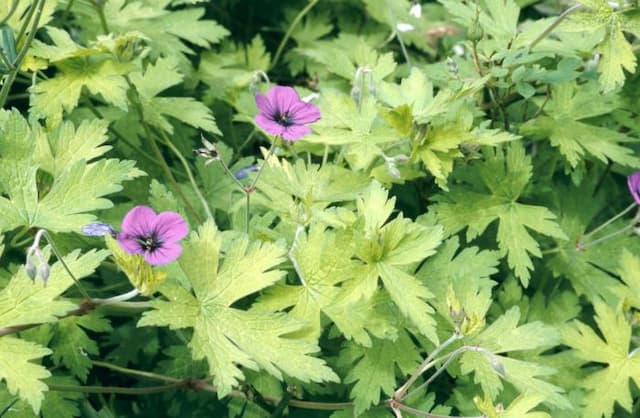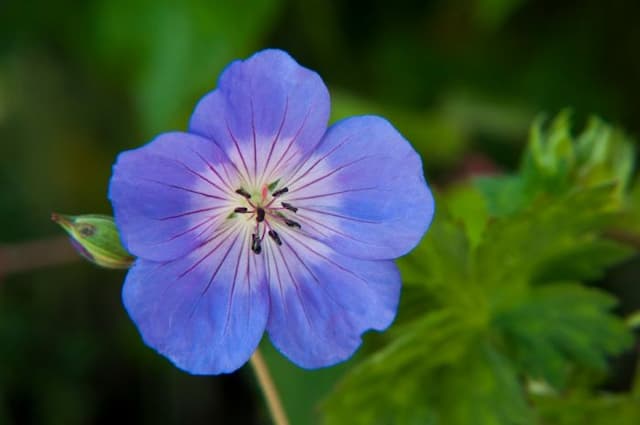Knotted Crane's-bill Geranium nodosum

ABOUT
Geranium nodosum, commonly known as the knotted crane's-bill, features a lush foliage of glossy, rounded leaves that are deeply lobed, giving them a somewhat ornate appearance. The surface of the leaves often carries a sheen and can occasionally show hints of a lighter or darker green depending on the variety. Throughout the blooming season, this hardy perennial produces charming flowers that are borne atop slender stems, which rise elegantly above the foliage. Each blossom typically has five petals and can be seen in shades of pink or lilac with delicate veining that adds a touch of intricacy to the simple yet graceful floral arrangement. The petals are rounded and slightly notched at the tips, further enhancing the overall soft and romantic look of the plant. The flowering stems and buds may exhibit a reddish or purplish tint, contrasting nicely with the green foliage. After blooming, the plant forms distinctive seed heads that have a beak-like appearance, which has likely influenced the common name referencing a crane's bill. This attractive perennial combines both ornamental foliage and delightful blooms, making it a popular choice for gardens and landscape settings where a touch of elegance and understated beauty is desired.
About this plant
 Names
NamesFamily
Geraniaceae.
Synonyms
Knotted Crane's-bill, Mountain Geranium, Shiny Geranium.
Common names
Geranium nodosum.
 Toxicity
ToxicityTo humans
Geranium nodosum, commonly known as the knotted crane's-bill, is not considered toxic to humans. Ingesting any part of this plant is unlikely to cause any serious symptoms of poisoning. However, it is generally advisable to avoid eating ornamental plants as they are not intended for consumption and may cause mild stomach upset in sensitive individuals.
To pets
Knotted crane's-bill is not known to be toxic to pets. If pets ingest parts of this plant, they are not typically expected to experience serious symptoms of poisoning. However, as with humans, consuming non-food plants can sometimes result in mild gastrointestinal upset in some animals.
 Characteristics
CharacteristicsLife cycle
Perennials
Foliage type
Semi-deciduous
Color of leaves
Green
Flower color
Pink
Height
1-2 feet (30-60 cm)
Spread
1-2 feet (30-60 cm)
Plant type
Herb
Hardiness zones
5
Native area
Europe
Benefits
 General Benefits
General Benefits- Attractive Flowering – Geranium nodosum produces beautiful lilac flowers which add aesthetic value to gardens and landscapes.
- Drought Tolerance – Once established, this hardy plant can tolerate periods of drought, making it suitable for xeriscaping and low-water gardens.
- Shade Tolerance – It can grow in shaded areas where other flowering plants might struggle, making it versatile for different garden locations.
- Ground Cover – With its spreading habit, Geranium nodosum is effective at covering bare ground, reducing weed growth, and preventing soil erosion.
- Pollinator-Friendly – The flowers of Geranium nodosum attract bees and other pollinators, supporting local biodiversity.
- Easy Propagation – This plant can be easily propagated through division, making it simple to increase your stock or share with other gardeners.
- Low Maintenance – It requires minimal care once settled in, with no need for regular fertilization or pruning.
- Seasonal Interest – Geranium nodosum offers seasonal interest from its flowering time in spring through to fall, with attractive foliage even when not in bloom.
 Medical Properties
Medical PropertiesThis plant is not used for medical purposes.
 Air-purifying Qualities
Air-purifying QualitiesThis plant is not specifically known for air purifying qualities.
 Other Uses
Other Uses- Adding visual diversity to gardens: Geranium nodosum can be planted among other shade-loving plants to create variations in texture and form.
- Supporting wildlife: This plant can attract beneficial insects like bees and butterflies, due to its nectar-rich flowers.
- Ground cover: Its spreading habit and shade tolerance make it useful for covering bare spots under trees or in woodland gardens.
- Education: Can be used as a specimen for botany classes to study plant structure and function.
- Photography: The attractive flowers of Geranium nodosum provide an excellent subject for nature photographers.
- Floral arrangements: The dainty flowers can be used in small, informal bouquets or table arrangements.
- Companion planting: It can be paired with other perennials that have similar growing requirements to create a cohesive garden design.
- Soil erosion control: The dense growth can help stabilize soil on slopes or in areas prone to erosion.
- Live fences: Can be grown in rows to create a low, living boundary that marks edges of garden paths or property lines.
- Garden art: Can be used alongside garden sculptures or decorative elements as a living backdrop that enhances the artistic features.
Interesting Facts
 Feng Shui
Feng ShuiThe Geranium is not used in Feng Shui practice.
 Zodiac Sign Compitability
Zodiac Sign CompitabilityThe Geranium is not used in astrology practice.
 Plant Symbolism
Plant Symbolism- Unity and Cooperation: Geraniums often symbolize togetherness and a spirit of cooperation, suggesting that people are stronger together than apart.
- Friendship: Sharing a geranium plant is seen as a gesture of kinship and warm feelings, making it a common gift between friends.
- Health and Healing: With their medicinal qualities, geraniums are associated with good health and recovery from illness, wishing wellness upon the receiver.
- Good Fortune: In some traditions, a geranium plant is thought to bring positive energy and luck to a home or garden.
- Peace: The geranium's calming scent and appearance are believed to provide peace and tranquility, making it a symbol of a stress-free existence.
 Water
WaterThe Geranium nodosum, commonly known as the Knotted Crane's-bill, prefers evenly moist soil without being waterlogged. Water the plant deeply once a week with about 1 gallon of water, ensuring the entire root zone is moistened. During hot or dry spells, increase frequency to twice a week. Allow the top inch of soil to dry out between waterings to avoid overwatering. In winter or cooler months, reduce the watering to every other week as the plant's water requirements decrease.
 Light
LightKnotted Crane's-bill thrives in partial shade to full sun. It is adaptable but does best with morning sun and afternoon shade, or dappled sunlight throughout the day. Avoid placing it in deep shade as this may result in fewer flowers and leggy growth. A spot under a tree that provides filtered light or a location with eastern exposure is ideal for this plant.
 Temperature
TemperatureKnotted Crane's-bill can survive in temperatures ranging from 35°F to 85°F. However, it grows best in temperatures between 65°F and 75°F. Ensure to protect the plant from frost and extreme heat as both can damage the plant. Mulching can help regulate soil temperature and protect the roots in extreme weather conditions.
 Pruning
PruningPruning Knotted Crane's-bill is necessary to remove dead or yellowing leaves and spent flower heads to encourage new growth and a tidy appearance. Prune lightly throughout the growing season as needed. The best time for a more thorough pruning is late winter or early spring, just before new growth begins, to shape the plant and remove any old, woody stems.
 Cleaning
CleaningAs needed
 Soil
SoilKnotted Crane's-bill thrives in a well-draining soil mix rich in organic matter, with a pH range between 5.8 to 6.8. A mix of loam, peat, and sand or perlite in equal parts is beneficial for optimal growth and health.
 Repotting
RepottingKnotted Crane's-bill usually does not require frequent repotting and can be repotted every 2 to 3 years, or when it outgrows its current container.
 Humidity & Misting
Humidity & MistingKnotted Crane's-bill prefers average room humidity levels and can tolerate some variation, without any special humidity requirements.
 Suitable locations
Suitable locationsIndoor
Place Knotted Crane's-bill in bright, indirect light indoors.
Outdoor
Grow Knotted Crane's-bill in partial shade with moist soil outdoors.
Hardiness zone
5-9 USDA
 Life cycle
Life cycleGeranium nodosum, commonly known as knotted crane's-bill, begins its life cycle as a seed, which germinates in moist, well-drained soil usually in the spring. Once the seedling emerges, it develops into a vegetative plant featuring characteristic lobed leaves and a sturdy stem. As it matures, knotted crane's-bill produces distinctive pink to lilac flowers with veined petals that attract pollinators, leading to the next stage of pollination and fertilization during the warmer months. Following successful fertilization, the plant sets seed within a beaked fruit capsule that, when ripe, dehisces to disperse seeds for the next generation. Throughout its life, Geranium nodosum is a perennial, meaning it can live for several years, going dormant in winter and resuming growth in spring. This cycle of dormancy and regrowth repeats annually, allowing the plant to spread and continue its lifecycle over multiple seasons.
 Propogation
PropogationPropogation time
Spring to Summer
For Geranium nodosum, commonly known as the knotted crane's-bill, the most popular method of propagation is through division. This is best done in either spring or autumn when the plant is not in active growth. To propagate by division, one should carefully dig up the plant, ensuring a good amount of root is attached to each piece. The root ball should then be gently pulled apart into smaller sections, each with several shoots and a healthy root system. These sections can then be replanted at the same depth they were growing before, spaced about 12 inches (approximately 30 centimeters) apart to give them enough room to grow. It is important to water the new plants thoroughly after planting and continue to provide water until they are well established.









